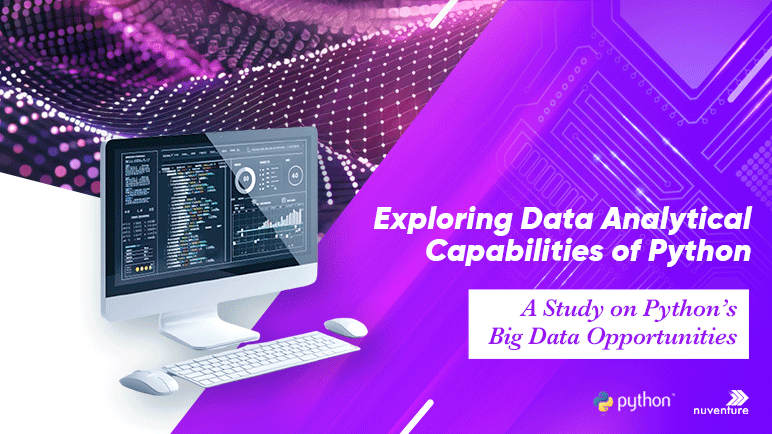Data analytics has always been a key to easy and better management Hunt down new opportunities, keep track of your competitor’s progress, foresee the market trend, gain insights into changing customer preferences. But how do you apply this technique to your business in a smart, yet easy way? Python, an easily flexible and scalable language with big fat library ecosystems is an ideal choice to perform data analytics. The blog discusses various techniques under the scope of Python that facilitate data driven analytics for businesses.
Why Python is the Best Choice for Data Analytics
- Wide scope for data visualization
Offering wide libraries and packages, Python leaves a bigger scope for various visualization possibilities of data. Here are a few libraries used for data visualization in Python:
- Matplotlib: Providing a MATLAB-like interface, this library helps in creating static, animated, and interactive plots. Scatter plots, line plots, pie charts, bar charts and much more, Matplotlib functions with arrays and fields of the dataset.
- Seaborn: Working with the whole data sets, Seaborn facilitates designing of complex visualization of data. With a high level of interface, you can create attractive drawings and informative statistical graphics with Seaborn.
- Plotly: Used for data visualization that includes customization of various data helping create interactive plots that can be embedded into web applications
- Bokeh: Using HTML and JavaScript for representing data in web browsers, Bokeh has the scope of making interactive visualization of data
- Seamless data manipulation and preparation:
The libraries of Python like pandas provide inbuilt data structures and tools for data cleaning:
- Eradicating duplicates
- Managing missing data
- Data transformation and normalization
- Integrating joining datasets
- Modifying data
Robust language for Machine Learning:
Reliable coding solutions demand rigorously tested environments. With easy-to-use and secure libraries and frameworks, Python makes Machine Learning integration look a piece of cake.
Here are a few reasons why Python best fits Machine Learning:
- Vast features
- Reliable tools
- Simplicity
- Independent platform
- Popular among the programming community
- Variety of frameworks and libraries
- Allow textual data analysis using Natural Language Processing:
A subset of Artificial Intelligence, Natural Language Processing (NLP) help machines comprehend human language to automate repetitive tasks. The automatic feature of spell check is a good example to define this technology. Python libraries for NLP facilitate processing of textual data.
- Natural Language Toolkit (NLTK): It provides tools for semantic reasoning, tokenization, parsing stemming, and tagging.
- spaCy: An open-source library that can support document analysis, chatbot capabilities, and all other forms of text analysis.
- Open to data integration and ETL (Extract, Transform, Load):
Python provides convenience and flexibility, depending on whitespace and common expressions. This means you can write fewer lines of code with a vast library and tools to proficiently manage your development time.
- Ease of use for big data and analytics:
The complexity of incorporating big data and analytics to business is minimized by the simplicity of Python, not restricting itself to a programming style. This gives the developer the freedom to choose the methodology they prefer like Object Oriented Programming (OOP), Functional Programming and so on. PySpark, the Python API for Apache Spark is an open-source framework fit for real-time, large-scale data processing; including the massive size associated with big data. PySpark Shell, with its incredibly faster performance, analyzes data interactively and proficiently. Developed to utilize distributed, in-memory data structures, this framework helps you scale up your tasks in clusters. Besides, the non-complex license structure of Python language allows hassle-free development without third party interference on management. Some relief while working on taxing and complex data analytics projects!
- With wide integration capabilities:
SQL databases, NoSQL databases, and big data frameworks like Apache Hadoop and Spark, and the list goes on. Python’s seamless integration with these languages and tools makes development with large data sets easier.
- Advocated by active communities:
With innumerable features that add to smooth development, Python has a large community of developers and users, with a plethora of tutorials, resources, documentations that are updated regularly: all highlighting minimal development blockages and active support.
Python has always been the primary language for significant data-driven decisions in many organizations. This spreading adoption of the language itself spotlights the undisputable features of the language. However, expert solutions come out only of expert handling of the frameworks and libraries of Python. Set your targets first, adopt a tech expert and experience the magic of data analytics. Don’t be amazed by your accelerated growth. So, if your business targets are set, contact the experts now. Nuventure’s Python experts are just a click away.
